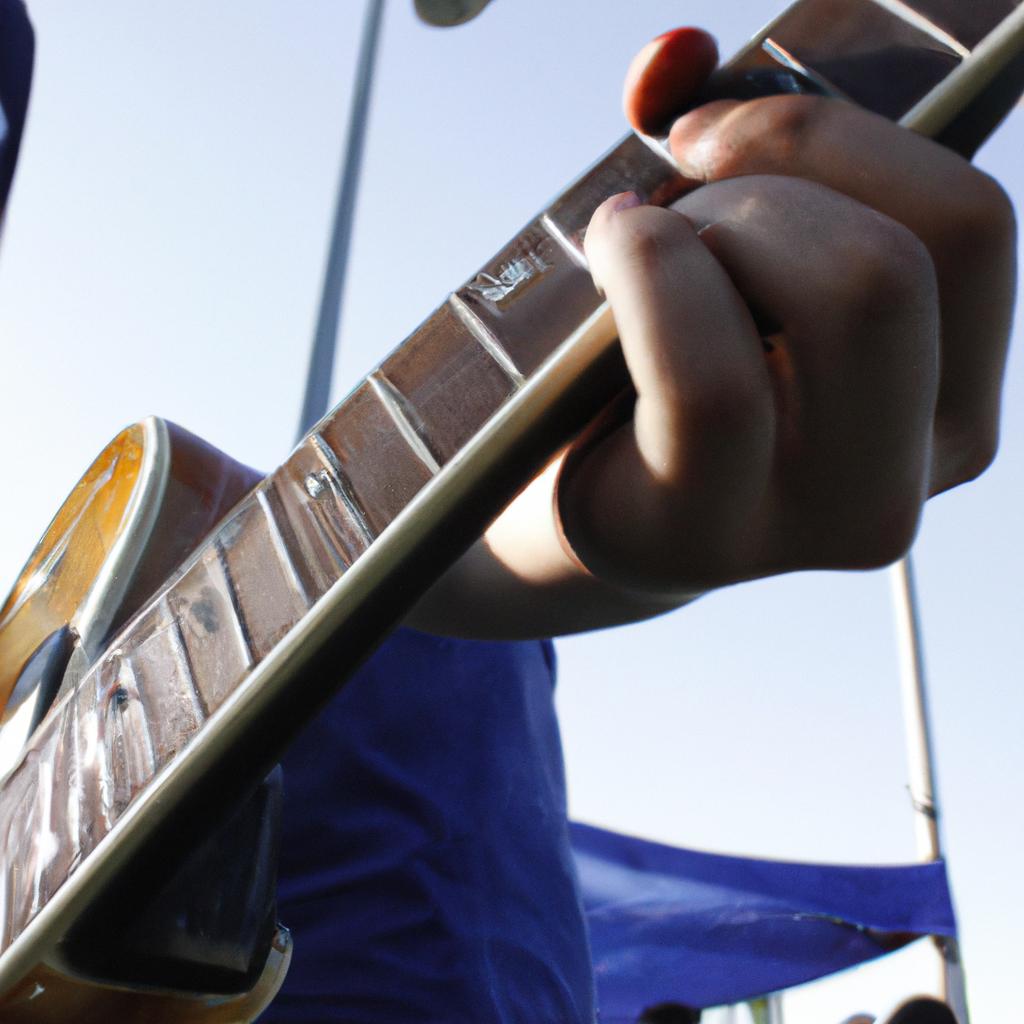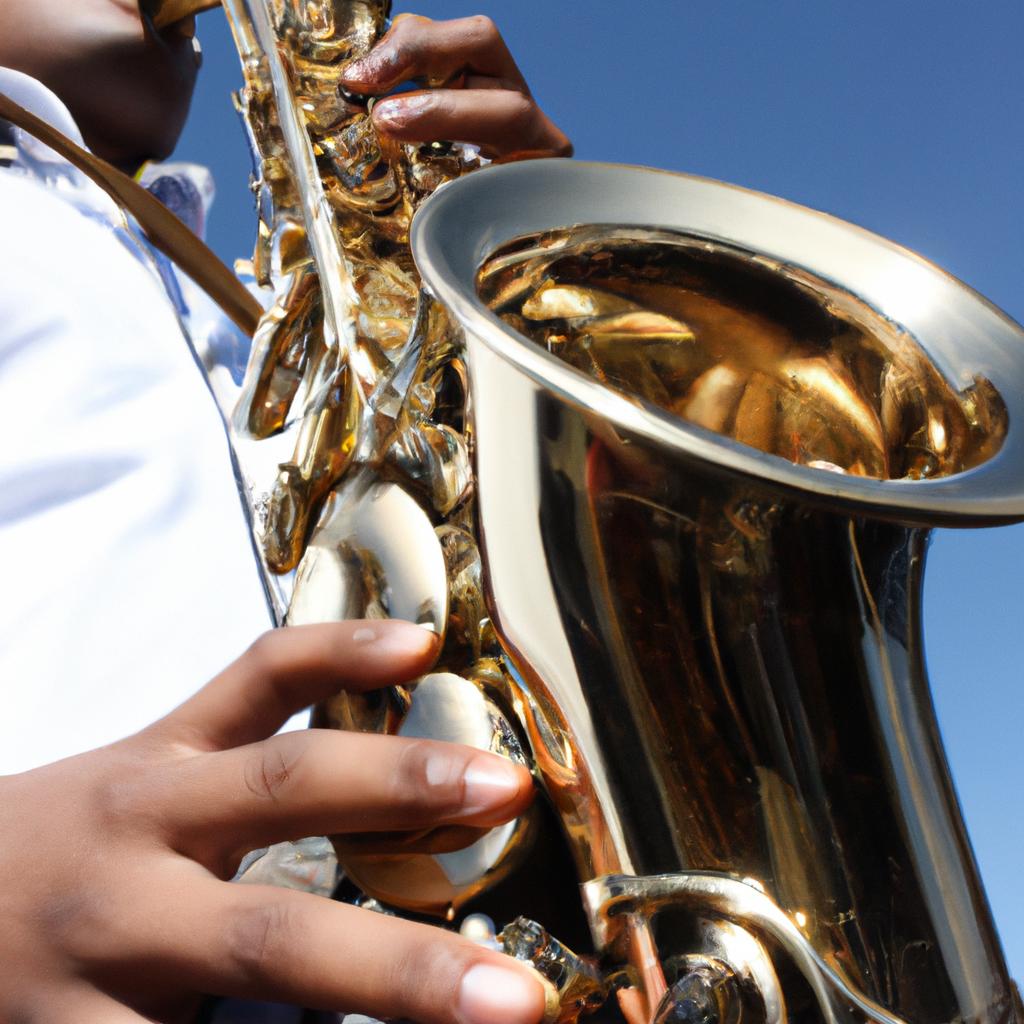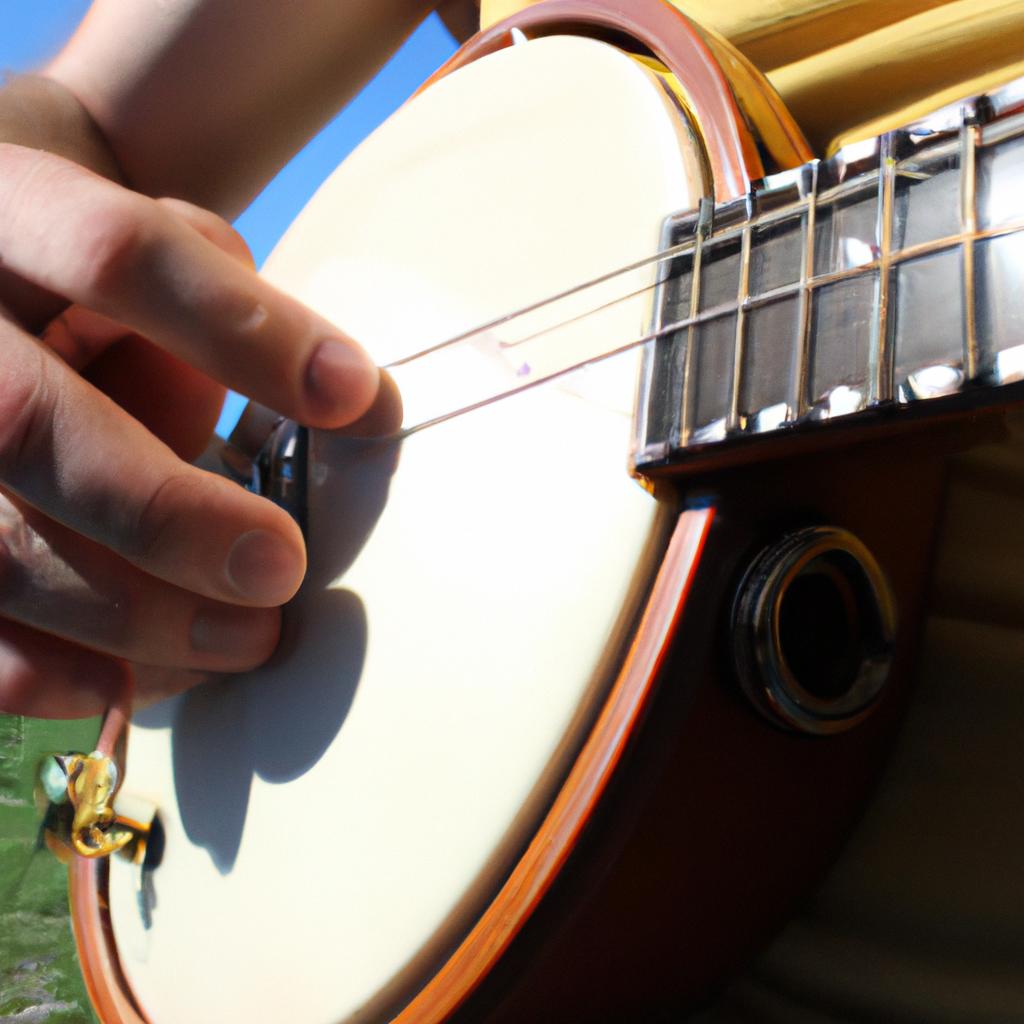Indigenous music and festivals in North America have long been celebrated for their vibrant sounds, rich cultural heritage, and profound impact on both local communities and the broader society. From the rhythmic beats of traditional drums to the soulful melodies sung in ancient languages, Indigenous music serves as a powerful medium through which stories are told, histories are preserved, and identities are reaffirmed. For instance, imagine attending the Gathering of Nations Powwow in Albuquerque, New Mexico – one of the largest powwows in North America that brings together thousands of dancers and drum groups from various Indigenous nations. This mesmerizing event showcases an array of captivating performances that not only entertain but also serve as a testament to the resilience and strength inherent within Indigenous cultures.
In addition to its artistic significance, Indigenous music plays a crucial role in promoting social cohesion and community building among Native peoples. Festivals centered around Indigenous music provide platforms for intergenerational knowledge transfer, fostering connections between elders who share their wisdom with younger generations eager to learn about their ancestral traditions. These gatherings also create spaces for networking among artists, educators, researchers, policymakers, and other stakeholders interested in supporting and preserving Indigenous musical practices. Furthermore, these festivals often attract visitors from diverse backgrounds who gain insights into the complexities of Indigenous world views and develop a deeper appreciation for the diversity of Indigenous cultures.
Indigenous music festivals offer an opportunity for non-Indigenous individuals to engage with and learn from Indigenous communities. Through performances, workshops, and interactive sessions, attendees can gain a better understanding of the historical context, significance, and meaning behind different musical traditions. This exchange promotes cultural understanding, challenges stereotypes, and fosters respect for Indigenous peoples’ contributions to the arts.
Moreover, these festivals often serve as platforms for advocacy and raising awareness about important issues affecting Indigenous communities. Musicians may use their artistry to address social justice concerns, environmental stewardship, land rights, and other matters that impact their lives. By amplifying these voices through music, festivals become catalysts for conversation and action.
It is worth noting that while attending Indigenous music festivals can be a transformative experience, it is essential to approach them with respect and humility. Visitors should prioritize listening and learning from Indigenous artists rather than appropriating or commodifying their cultural practices. It is crucial to honor protocols set by event organizers and seek permission before capturing or sharing any content related to sacred rituals or ceremonies.
In summary, Indigenous music festivals in North America celebrate the vibrancy of Native cultures while providing opportunities for education, dialogue, community-building, and advocacy. These events showcase the richness of Indigenous musical traditions while fostering cross-cultural understanding among diverse audiences.
Indigenous Music: A Celebration of Culture
Imagine yourself standing in a vast open field, surrounded by the gentle rustling of leaves and the distant sound of drums. As you listen closely, you are transported into a world where music becomes a powerful medium for cultural expression and celebration. Indigenous music has long been an integral part of North American indigenous communities, reflecting their rich heritage and deep connection to the land.
One example that showcases this vibrant musical tradition is the annual Gathering of Nations Powwow held in Albuquerque, New Mexico. This gathering brings together thousands of indigenous people from various tribes across North America to showcase their unique music and dance styles. The beating of drums resonates through the air as dancers adorned in colorful regalia gracefully move to the rhythm. It is a mesmerizing spectacle that not only celebrates indigenous culture but also serves as a platform for community-building and intertribal exchange.
The significance of indigenous music goes beyond mere entertainment; it serves as a means to preserve ancestral knowledge, transmit stories, and maintain cultural identity. Through its distinctive melodies, rhythms, and lyrics, indigenous music encapsulates centuries-old traditions passed down through generations. It acts as a living testament to resilience in the face of colonization and assimilation attempts.
To fully grasp the emotional impact and importance of indigenous music within these communities, consider the following:
- Indigenous music provides a sense of belonging and unity among individuals who have often faced marginalization.
- It fosters pride in one’s heritage while instilling a strong cultural identity.
- Traditional instruments such as flutes or rattles create an ethereal ambiance that connects listeners with nature.
- Dance forms specific to each tribe carry profound spiritual meaning and strengthen ties between past, present, and future generations.
Table 1 below illustrates some examples of traditional North American indigenous instruments commonly used in ceremonies:
| Instrument | Tribe | Purpose |
|---|---|---|
| Drum | Ojibwe | Represents heartbeat |
| Flute | Navajo | Invokes spiritual realm |
| Rattle | Hopi | Symbolizes rain |
| Powwow bells | Lakota | Signifies celebration |
In light of this rich musical heritage, further exploration into the history and evolution of North American indigenous music is warranted. The subsequent section will shed more light on the diverse genres and cultural significance associated with these captivating sounds.
The Rich History of North American Indigenous Music
Indigenous Music and Festivals: The Vibrant Sounds of North America
Transitioning from the previous section’s exploration of Indigenous music as a celebration of culture, we now delve into the rich history that underlies this vibrant art form. To illustrate the profound influence of Indigenous music in contemporary society, let us consider a hypothetical scenario where an annual Native American music festival takes place in a small town. This event serves as a microcosm for the larger cultural significance of Indigenous music across North America.
The festival showcases various musical traditions practiced by different tribes, highlighting their unique melodies, rhythms, and instruments. One can witness attendees immersing themselves in the diverse soundscape, experiencing firsthand the power of Indigenous music to foster connection and understanding. Beyond mere entertainment, these festivals serve as platforms for promoting cultural preservation and appreciation while also empowering Indigenous artists to share their voices with wider audiences.
To further appreciate the impact of Indigenous music and festivals on both individuals and communities, consider the following emotional responses elicited through bullet points:
- Awe-inspiring performances that evoke deep admiration
- Heartfelt moments shared between performers and audience members
- Soul-stirring melodies that transport listeners to another world
- Uplifting experiences that create a sense of unity among attendees
Moreover, examining some key characteristics associated with Indigenous music reveals its ability to captivate hearts and minds. The table below provides an overview:
| Characteristic | Description |
|---|---|
| Oral Tradition | Passing down knowledge through songs and storytelling |
| Connection | Deeply rooted connections to nature, ancestors, and spirituality |
| Cultural Identity | Expressing individual tribal identities within broader contexts |
| Resilience | Preserving heritage despite historical adversity |
In conclusion (avoid saying “In conclusion” or “Finally”), it is evident that Indigenous music has transcended time and continues to flourish today through vibrant festivals like the one described. This music serves as a powerful medium for cultural expression, fostering unity and appreciation among diverse audiences. As we move forward into our exploration of traditional instruments—the soul of Indigenous music—we will uncover the distinct sounds and histories that make this art form truly unique.
Transitioning smoothly to the subsequent section on “Traditional Instruments: The Soul of Indigenous Music,” we delve deeper into the captivating world where ancient melodies are brought to life through intricate instrumental craftsmanship.
Traditional Instruments: The Soul of Indigenous Music
Building upon the rich history of North American Indigenous music, this section explores the traditional instruments that have become the soul of these vibrant sounds. By delving into the intricacies and significance of these instruments, we can gain a deeper understanding of their cultural importance.
To illustrate the profound connection between Indigenous communities and their musical heritage, let us consider the example of the Navajo flute. This beautifully crafted instrument plays an integral role in Navajo culture, serving as both a means for personal expression and a conduit for spiritual communication. Its haunting melodies resonate through vast landscapes, carrying stories and emotions passed down from generation to generation.
The use of traditional instruments within Indigenous music represents more than just mere sounds; they embody centuries-old traditions and values. Here are some key aspects that make these instruments truly remarkable:
- Connection with nature: Many traditional indigenous instruments are made using natural materials such as wood, bone, or animal hides. This strong bond with nature symbolizes a reverence for the Earth and its resources.
- Oral transmission: The playing techniques and knowledge surrounding these instruments are often taught orally, highlighting the importance of intergenerational learning and preserving cultural heritage.
- Ritualistic purposes: Traditional instruments play significant roles in various ceremonies and rituals within Indigenous cultures. They serve as tools to communicate with ancestors, invoke spirits, celebrate harvests, or mark important life events.
- Community engagement: Playing these instruments is not limited to individuals; it often involves collective participation. Group performances strengthen community bonds and foster a sense of belonging among tribe members.
Table showcasing examples of traditional indigenous instruments:
| Instrument | Tribe | Function |
|---|---|---|
| Powwow Drum | Plains Tribes | Ceremonial |
| Inuit Throat Singing | Inuit | Storytelling |
| Apache Fiddle | Apache | Celebration |
| Hopi Flute | Hopi | Spiritual Connection |
In exploring the traditional instruments that form the heart of Indigenous music, we recognize their immense cultural significance. These instruments not only create beautiful melodies but also serve as vessels through which heritage is passed down and celebrated. As we continue our journey into the world of Indigenous festivals, it becomes evident how these instruments play a crucial role in shaping the overall experience and atmosphere.
Understanding the soulful nature of traditional instruments sets the stage for exploring another aspect of Indigenous culture – the vibrant festivals that bring communities together. In examining these celebrations, we can appreciate how they contribute to preserving and showcasing Indigenous traditions while fostering unity among diverse tribes.
Cultural Significance of Indigenous Festivals
Traditional Indigenous music is not only characterized by its unique sounds but also by the instruments used to create these vibrant melodies. These traditional instruments hold a significant place in the hearts of Indigenous communities across North America, acting as the soul of their music. From drums and flutes to rattles and stringed instruments, each instrument plays a crucial role in preserving cultural heritage.
One fascinating example that showcases the importance of traditional instruments is the annual Gathering of Nations powwow held in Albuquerque, New Mexico. This gathering brings together Indigenous peoples from various tribes who showcase their rich musical traditions through dance and song. The beating of large drums accompanied by mesmerizing flute melodies captivates both participants and spectators alike, creating an enchanting atmosphere.
The use of traditional instruments in Indigenous music serves multiple purposes, including:
- Preserving Cultural Identity: Traditional instruments are passed down through generations, ensuring the continuity of cultural practices and beliefs.
- Connecting with Ancestral Spirits: Many Indigenous communities believe that playing these instruments allows them to communicate with their ancestors and invoke spiritual connections.
- Storytelling: Each instrument has its own unique sound that helps convey stories, histories, and messages encoded within the music.
- Healing and Ceremony: Traditional music often accompanies healing ceremonies or other sacred rituals within Indigenous cultures, providing solace and restoration.
To further illustrate the significance of traditional instruments in Indigenous music, consider the following table showcasing some commonly used instruments among different Native American tribes:
| Tribe | Instrument | Description |
|---|---|---|
| Navajo | Flute | Handcrafted wooden flute producing haunting tones |
| Lakota Sioux | Drum | Large hide drum played using hands or mallets |
| Haida | Rattle | Carved wooden rattle filled with shells or pebbles |
| Inuit | Jew’s Harp | Small metal mouth harp producing rhythmic sounds |
These instruments, along with countless others, contribute to the diverse tapestry of Indigenous music and festivals. They provide a window into the rich cultural heritage that has been passed down through generations.
Transitioning into the subsequent section about “Contemporary Indigenous Music: Blending Tradition and Modernity,” it is important to recognize how traditional instruments continue to shape and influence contemporary Indigenous music. While preserving their ancestral roots, modern Indigenous musicians have found ways to incorporate elements from other genres while maintaining their unique musical identities. By embracing new technologies and experimenting with different styles, they are creating a fusion that both honors tradition and embraces innovation.
Contemporary Indigenous Music: Blending Tradition and Modernity
Building upon the cultural significance of Indigenous festivals, we now delve into the realm of contemporary Indigenous music. This dynamic genre not only preserves and celebrates traditional musical elements but also embraces modern influences, creating a unique fusion that captures the essence of North America’s diverse Indigenous cultures.
Contemporary Indigenous music is an evolving art form that showcases the rich heritage and resilience of Indigenous communities across North America. One notable example is the work of Tanya Tagaq, an Inuk throat singer from Canada. Through her powerful vocals and innovative techniques, Tagaq pushes boundaries and challenges preconceived notions about Indigenous music within mainstream society. Her ability to blend tradition with modernity has garnered international acclaim and serves as an inspiration for aspiring musicians seeking to honor their roots while exploring new artistic horizons.
To understand the distinct characteristics of contemporary Indigenous music, it is essential to explore its key components:
- Cultural Preservation: Contemporary Indigenous artists actively preserve their ancestral languages and traditions through their lyrics, melodies, and instrumentation. By incorporating these elements into their compositions, they ensure that ancient knowledge and stories are passed down to future generations.
- Interconnectedness: Many contemporary Indigenous musicians strive to create a sense of interconnectedness among different tribes and cultures. They collaborate with fellow artists from various backgrounds, fostering unity and solidarity within Native communities.
- Social Commentary: The songs often serve as a platform for social commentary on issues such as identity, land rights, environmental conservation, and historical injustices faced by Indigenous peoples. These poignant expressions shed light on important topics while encouraging dialogue beyond conventional platforms.
- Innovation: While rooted in tradition, contemporary Indigenous music embraces innovation by incorporating modern instruments like electric guitars or synthesizers alongside traditional drums, flutes, or rattles. This amalgamation creates a harmonious balance between past traditions and present realities.
To illustrate the diversity within this genre further, consider the following table showcasing some influential contemporary Indigenous musicians and their respective tribes:
| Musician | Tribe | Notable Works |
|---|---|---|
| A Tribe | Navajo | “Reservation Radio,” “Eagle Vision” |
| Buffy Sainte-Marie | Cree | “Universal Soldier,” “Up Where We Belong” |
| Radmilla Cody | Diné (Navajo) | “Shii Nah Baa’ ‘Aaníígóó’ |
| Jeremy Dutcher | Wolastoqiyik | “Mehcinut” |
As we can see, contemporary Indigenous music encompasses a vast array of artists and styles that reflect the vibrancy and diversity of North America’s Indigenous cultures. By blending traditional musical elements with modern influences, these musicians create an auditory experience that resonates deeply within both Indigenous communities and broader society.
As we immerse ourselves in the captivating world of contemporary Indigenous music, it becomes clear that attending Indigenous festivals provides an unparalleled opportunity to witness these vibrant sounds firsthand. Must-Visit Indigenous Festivals in North America offer immersive cultural experiences where music intertwines with dance, storytelling, visual arts, and culinary traditions. Let us now explore some of these incredible gatherings that showcase the richness and creativity of Indigenous cultures across the continent.
Must-Visit Indigenous Festivals in North America
Transitioning from the contemporary indigenous music scene, we now delve into the vibrant world of indigenous festivals in North America. These gatherings provide a unique platform for indigenous communities to showcase their rich cultural heritage through music, dance, storytelling, and art. One such festival that encapsulates this celebration is the Gathering of Nations Powwow held annually in Albuquerque, New Mexico.
The Gathering of Nations Powwow serves as an exceptional case study on how these festivals become catalysts for preserving and promoting indigenous culture. With over 700 tribes participating, it stands as one of the largest powwows in North America. The event features various activities such as traditional dances performed by tribal members adorned in elaborate regalia, drumming circles resonating with rhythmic beats echoing throughout the venue, and arts and crafts exhibitions displaying intricate works created by talented artisans.
Attending an indigenous festival can be a profoundly moving experience, evoking a range of emotions within participants. Here are some aspects that contribute to this emotional response:
- Unity: Witnessing diverse indigenous communities come together to celebrate their shared heritage fosters a sense of unity among attendees.
- Resilience: Learning about the challenges faced by indigenous peoples throughout history and witnessing their perseverance instills admiration for their resilience.
- Pride: Observing individuals proudly showcasing their customs and traditions ignites a deep sense of pride not only within themselves but also among those who witness their performances.
- Connection to Nature: Many indigenous festivals incorporate elements of nature, emphasizing the connection between people and the land they have inhabited for centuries.
To further explore the diversity of these festivals across North America, let’s take a closer look at some notable events:
| Festival | Location | Key Features |
|---|---|---|
| Gathering of Nations | Albuquerque, NM | Massive gathering featuring dance competitions and art exhibitions |
| Indian Summer | Milwaukee, WI | Showcases indigenous music, cultural exhibits, and traditional cuisine |
| Inuit Art Showcase | Iqaluit, Nunavut | Highlights the talent of Inuit artists through vibrant art exhibitions |
| Red Earth Festival | Oklahoma City, OK | Celebrates Native American culture with dance performances and parades |
In conclusion, indigenous festivals provide a platform for communities to celebrate their heritage while fostering unity among diverse tribes. These gatherings evoke emotions by showcasing resilience, instilling pride in one’s identity, and emphasizing the deep connection between indigenous peoples and nature. With each event unique in its offerings and atmosphere, attending an indigenous festival is both educational and emotionally transformative.
 Island Gourmet Safaris
Island Gourmet Safaris



